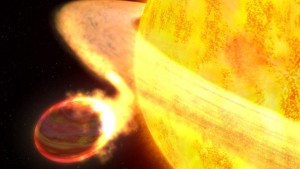 Final day of the IAU meeting general assembly found me in talks about transit-timing variations, tidal interactions, and planets in binary star systems.
Final day of the IAU meeting general assembly found me in talks about transit-timing variations, tidal interactions, and planets in binary star systems.
The first session focused on the impressive results from transit-timing variation (TTV) studies. Since detecting and modeling TTVs is very data-intensive, the talks explored the data science aspects of TTV analysis. Ben Montet‘s talk, for example, looked at how hard it can be to detect transits in the first place, much less measure their period variations. To estimate uncertainties on their variations, he advocated using importance sampling and generating thoroughly explored prior distributions.
The next session looked at tidal interactions and planets in binary star systems. Smadar Naoz talked about her work on Kozai oscillations and how she showed that Kozai had made some fairly specific assumptions that limited his famous dynamical analysis in important ways. Her improved analysis shows that, contrary to the original results, the Kozai mechanism can actually produce planets on retrograde orbits and so can help explain the growing number of such retrograde planets.
I also spoke in the second session about Roche lobe overflow in short-period gaseous exoplanets, and I’ve posted my presentation below.
So, all in all, a really brilliant conferences in an inspiring locale. Mahalo, Hawaii.
—
Tidal Decay and Disruption of Gaseous Exoplanets




